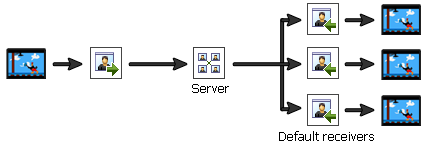Methods working with a list of default receivers on the server.
procedure AddDefaultReceiver(GUID : TGUID);
procedure RemoveDefaultReceiver(GUID : TGUID);
procedure HelloToDefaultReceivers;
procedure GoodbyeToDefaultReceivers;
The methods work only if this sender is connected to TRVMediaServer via the network.
Audio and video are sent to default receivers if GUIDTo and GUIDGroups are empty. Commands and files can be sent to default receivers as well.

A server may create a list of default receivers for each client. A client itself adds and removes default receivers by calling AddDefaultReceiver/RemoveDefaultReceiver.
A client may inform its default receivers about its presence by calling HelloToDefaultReceivers, and inform them about exiting by calling GoodbyeToDefaultReceivers. If HelloToDefaultReceivers was called, and connection between this client and the sever is broken, the server itself informs default receivers about this client exiting. Default receivers are informed in OnUserEnter and OnUserExit events.
The list of default receivers can be kept by the server when this client disconnects, if you change TRVMediaServer.KeepClientInfoMode.
In addition, the component provides a set of methods for simplifying a management of default receivers:
•SendMediaAccessRequest, SendMediaAccessCancelRequest (requests for addition/removal in the list of default receivers)
•AllowMediaAccess, CancelMediaAccess (alternative methods for adding and removing to the list of default receivers)